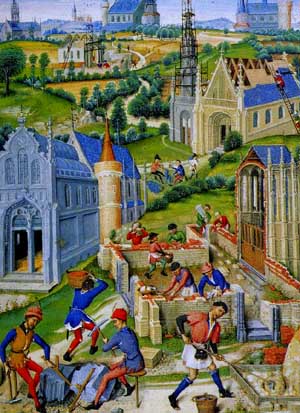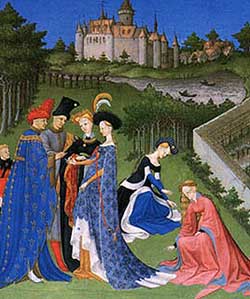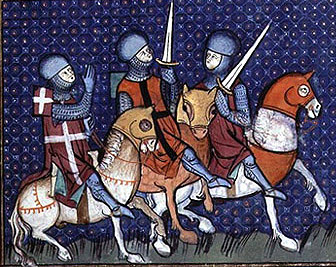 |
World History
A World of Brilliant Colors
Hugh O’Reilly
Anyone who has watched medieval movies and television shows knows that part of Hollywood's agenda is to portray the “little people” of the Middles Ages as dirty, starving and miserable, as the exploited victims of fanatic clergymen and corrupt nobles. It is common to find this distorted picture in scenes of The Name of the Rose, The Kingdom of Heaven, Ivanhoe, Braveheart, Robin Hood, the Cadfeal series. The list goes on and on.
It is an unwritten rule followed by the tsars of Hollywood: The medieval people only wore brown rags and never bathed or combed their hair. Not only in movies do we find this "revised history." Also Protestants, as well as the followers of the French Revolution and Communism, want the glorious Catholic past to be misrepresented.
In fact, the Middle Ages was the opposite of drab and dreary. It was distinguished for the vivid colors that enriched the streets of the cities, the workplaces and the battlefields. Below, we will be following French scholar Regine Pernoud, who describes the charm and rich colors of the clothing of both the grand and small people of the Catholic medieval world.
Color is a striking feature of medieval costume. The medieval world was a world of color and a street scene in those days must have been an enchantment to the eye. Against the background of painted façades of the shops, with their shining signs hanging outside, moved the figures of men and women all dressed in bright colors, which contrasted sharply with the black robes of the clerics, the brown frieze of the mendicant friars and the brilliant whiteness of coifs or hennins.

Workers building a cathedral in a 13th century city |
It is hard to imagine such a riot of color in the modern world, unless it is in processions - still seen in England - on the occasion of the marriage of a prince or the coronation of a king, or in certain religious ceremonies that take place in the Vatican. But in the Middle Ages it was not only ceremonial robes that were richly colored. Simple peasants also dressed in bright colors, reds, yellows and blues. The Middle Ages seem to have had a horror of dark shades and everything that has come down to us - frescoes, miniatures, tapestries and stained glass windows - bear witness to this richness of color, which was so characteristic of the period.
One must not, however, exaggerate the picturesque or the eccentricity of medieval costume. Certain details of dress, which one associates inevitably with the pictures of the time, were only worn exceptionally: Shoes with long pointed toes, for instance, were fashionable for no more than 50 years of the 15th century – properly speaking, already an age that represented the excesses of the Renaissance, a period of many exaggerations in clothing.
In the Middle Ages, women’s outer garment reached to the elbows, and the under-sleeves, of a lighter material, reached to the wrists. The neck was generally left uncovered and skirts trailed on the ground; they were held up by a belt, fastened, sometimes, with a jeweled clasp.
The men also wore surcoats, which were shorter, and the hose and sometimes the breeches showed below the tunic. In the course of the 12th century, under the influence of the Crusades, long flowing garments were adopted, a fashion which was sharply censured by the Church as being effeminate.
The noble and the simple had nice garments
The peasants wore a sort of hooded cape, and the bourgeois covered their heads with felt or fabric hoods. Furs were very popular, ranging from the ermine reserved for kings and princes, marten and miniver, to the simple fox-furs and sheepskins from which the villagers made shoes, bonnets and coats for themselves.

Nobles in a hunt, from the Book of Hours of the Duc de Berry |
In the 15th century, great lords such as the Duke of Berry used valuable furs and it was also at this time – the Renaissance and not the Middle Ages - that costume became more elaborate, breeches were made tight and close-fitting, tunics were shortened exaggeratedly and drawn in at the waist, and shoulders were padded.
Many varieties of materials for garments could be bought by the people at the great fairs throughout France. Refined fabrics from the textile industries of Flanders and the Northern France were sold in the Mediterranean towns: cloth from Chalons, strong muslin from Arras, woolens from Douai, Cambrai, Saint Quentin and Metz, red draperies from Ypres, 'estanforts' from England, fine material from Rheims, soft and hard felts from Provins, not to mention local specialties like the brown fabric from Narbonne and the grey and green cloth from Avignon.
Silk and velvet were for a long time the prerogative of the nobility. Even though they were the ones who usually purchased them, on special occasions they liked to distribute such clothing among their followers of every rank. By the 13th century these rich materials were easily available to many of the city merchant class.
In fact, the medieval noble was not known for excessive luxury of dress. There was no excessive luxury while the Capets (987-1328) were on the throne. It was not until the time of the Valois (1328-1589) that the court became magnificent - and then magnificence was to be found more particularly at the courts of the princes of apanages, for instance, those of the Dukes of Berry, Burgundy and Anjou. It is well known, on the other hand, that men such as Louis the Young, St. Louis and Philippe-August were conspicuous for the plainness of their dress, which was often more simple than that of their vassals.
The military attire
As far as military dress was concerned, it would be a mistake to imagine that the medieval knight wore the heavy and elaborate armor to be seen in museums today; this did not make its appearance before the end of the 14th century.
In the 12th and 13th centuries, armor consisted mainly of a coat of mail reaching to just above the knees, and a helmet which, originally heavy and cumbersome, was improved and equipped with visors and adjustable chin, forehead and nose-pieces. An overcoat of some colorful or distinguishing material was slipped over the hauberk or coat of mail to lessen its brilliance. Greaves and spurs completed the soldier’s equipment. The fine statue of the Chevalier de Bamberg gives one an excellent idea of the medieval military dress – a harmonious masterpiece of virile simplicity.

Medieval knights |
But an extra effort of imagination is needed to reconstruct the dazzling spectacle that must have been presented by medieval arms: this multitude of helmets, lances and swords flashing in the sunlight so that their reflection was often a cause of defeat for those who happened to be disadvantageously placed.
It was at the beginning of the 12th century that coats of arms were first seen. Again, the vivid colors so beloved by the medieval were plentiful, and people relied on those splashes of colors to follow the movements of the various knights and houses on the tournament fields or in processions.
Coats of arms were also an integral part of medieval life. They gave pictorial expression to the motto of the lord, or rather, the family, and were at once a war cry and a call to arms. Each color had a meaning, as did each charge: azure was symbol of loyalty, red of courage, sable of prudence and green of courtesy. Of the two metals, silver signified purity, and gold, love and ardor.
From the time of its first appearance the escutcheon formed a science and sort of specialized language, interpreting the rich and colorful forms beloved of the Middle Ages.

Based on Regine Pernoud, The Glory of the Medieval World
London: Dennis Dobson, n.d., pp. 237-242
Posted October 1, 2011

Related Topics of Interest
 The Middle Ages, a Forest Filled with Symbols The Middle Ages, a Forest Filled with Symbols
 The Great Adventure of the Templars The Great Adventure of the Templars
 Refuting Myths of the Middle Ages Refuting Myths of the Middle Ages
 Women in the Middle Ages Women in the Middle Ages
 Departure for the First Crusade Departure for the First Crusade
 Hernan Perez del Pulgar of the Valiant Deeds Hernan Perez del Pulgar of the Valiant Deeds
 The Three Orders of Medieval Society The Three Orders of Medieval Society

Related Works of Interest
|
|
History | Home | Books | CDs | Search | Contact Us | Donate

© 2002- Tradition in Action, Inc. All Rights Reserved
|
 |
|